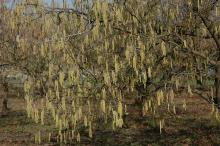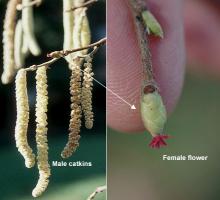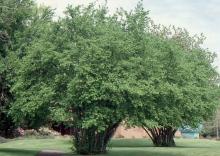Corylus avellana
Common name:
Hazelnut
European Filbert
European Hazel
Pronunciation:
KO-ril-us a-ve-LAH-na
Family:
Betulaceae
Genus:
Type:
Broadleaf
Native to (or naturalized in) Oregon:
No
- Deciduous shrub/tree, 12-20 ft (3.7-6 m), rounded crown, erect shoots, and produces many suckers. Leaves alternate, simple, broad, roundish, 7.5-10 cm long. Greenish yellow male flowers (catkins) hang on all winter, are yellowish as they release pollen in early winter. Female flowers are nearly inconspicuous, with only the bright red 1–3 mm long styles visible. The fruit is a nut which is enclosed by a short leafy husk (involucre). The nut is in clusters of 1-5, and when ripe in late summer it falls out of the involucre. It is yellow-brown, more or less spherical and about 1.5-3 cm long.
- Sun to part shade.
- Hardy to USDA Zone 4 Native to Europe, north Africa, and western Asia.
- This is the commercial hazelnut, essentially the entire US crop is produced in Oregon on some 70,000 acres. Hazelnut orchard in flower (winter) and late summer (near fruit drop).
-
There are several selections that are used in landscaping, these include:
- 'Contorta' - stems are curled and twisted as are the leaves
- 'Red Dragon' - burgundy colored catkins and leaf buds, and rich dark burgundy-colored leaves
- 'Red Majetic' - compact and outward spreading to semi-weeping, stems twisted, leaves a rich, dark burgundy in spring and summer
- 'Rote Zeller' - catkins are reddish-purple, then red leaves emerged which turn bronze-red in late summer
- avellana: deived from Avella Vecchia, Italy. Apparently Linnaeus, who named the plant, read an account of it in a text by Leonhart Fuch in which he described it as the "Avellana nux sylvestris” ("wild nut of Avella") (Wikipedia).
Click image to enlarge











